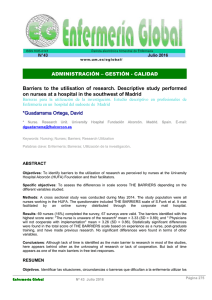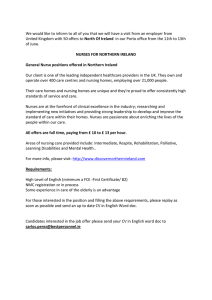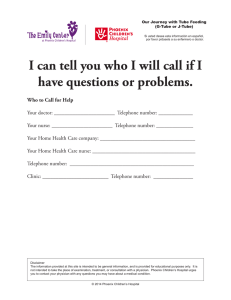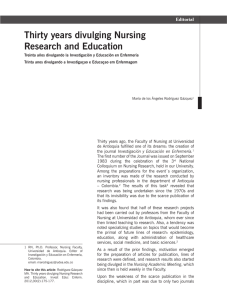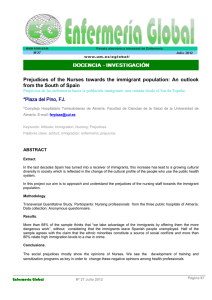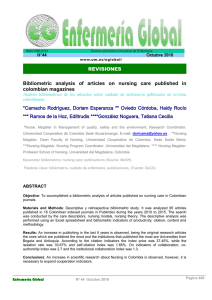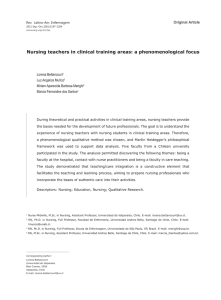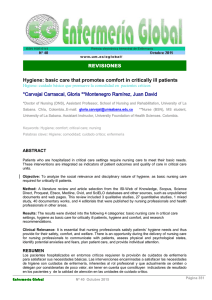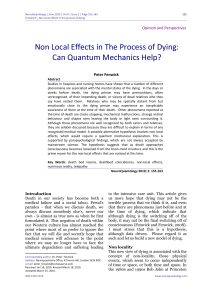Nursing Students` Reflections on the Death Process
Anuncio
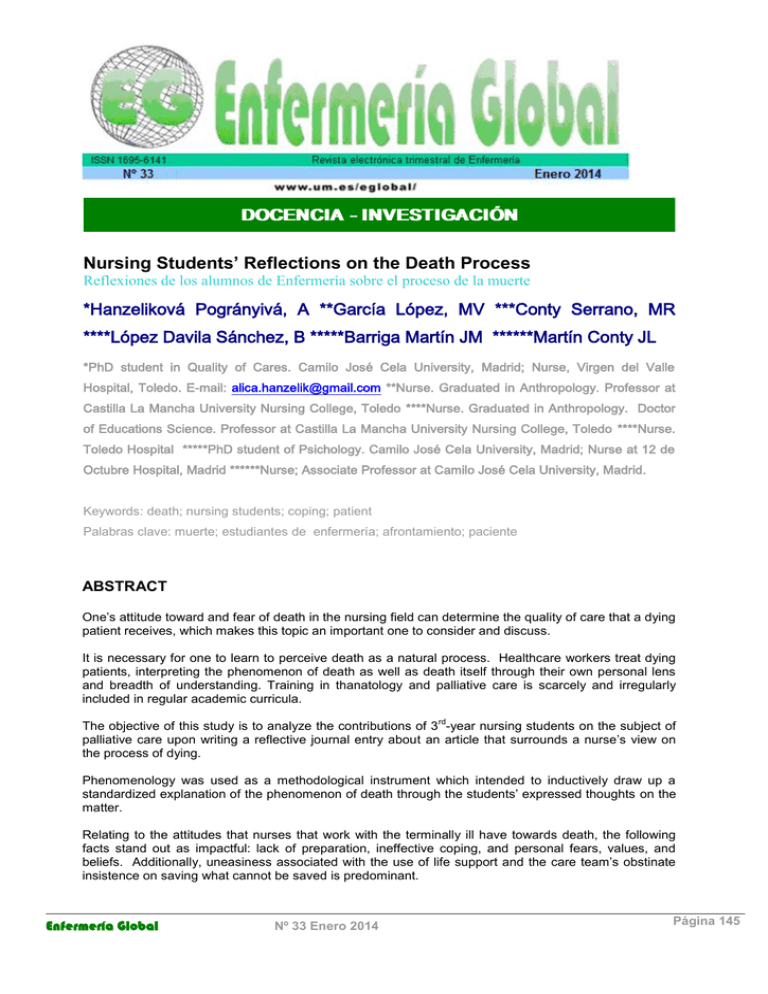
DOCENCIA - INVESTIGACIÓN Nursing Students’ Reflections on the Death Process Reflexiones de los alumnos de Enfermería sobre el proceso de la muerte *Hanzeliková Pogrányivá, A **García López, MV ***Conty Serrano, MR ****López Davila Sánchez, B *****Barriga Martín JM ******Martín Conty JL *PhD student in Quality of Cares. Camilo José Cela University, Madrid; Nurse, Virgen del Valle Hospital, Toledo. E-mail: [email protected] **Nurse. Graduated in Anthropology. Professor at Castilla La Mancha University Nursing College, Toledo ****Nurse. Graduated in Anthropology. Doctor of Educations Science. Professor at Castilla La Mancha University Nursing College, Toledo ****Nurse. Toledo Hospital *****PhD student of Psichology. Camilo José Cela University, Madrid; Nurse at 12 de Octubre Hospital, Madrid ******Nurse; Associate Professor at Camilo José Cela University, Madrid. Keywords: death; nursing students; coping; patient Palabras clave: muerte; estudiantes de enfermería; afrontamiento; paciente ABSTRACT One’s attitude toward and fear of death in the nursing field can determine the quality of care that a dying patient receives, which makes this topic an important one to consider and discuss. It is necessary for one to learn to perceive death as a natural process. Healthcare workers treat dying patients, interpreting the phenomenon of death as well as death itself through their own personal lens and breadth of understanding. Training in thanatology and palliative care is scarcely and irregularly included in regular academic curricula. rd The objective of this study is to analyze the contributions of 3 -year nursing students on the subject of palliative care upon writing a reflective journal entry about an article that surrounds a nurse’s view on the process of dying. Phenomenology was used as a methodological instrument which intended to inductively draw up a standardized explanation of the phenomenon of death through the students’ expressed thoughts on the matter. Relating to the attitudes that nurses that work with the terminally ill have towards death, the following facts stand out as impactful: lack of preparation, ineffective coping, and personal fears, values, and beliefs. Additionally, uneasiness associated with the use of life support and the care team’s obstinate insistence on saving what cannot be saved is predominant. Enfermería Global Nº 33 Enero 2014 Página 145 The results emphasize a very elevated level of the nurse’s emotional involvement in caring for a dying patient. Specific preparation geared toward a better adaptation in working with terminal patients has been identified as a fundamental pillar for nurses in this line of work. Personal interest and emphasis on occupational excellence also stand out as influential factors. It is very important to analyze the problems regarding this “environment of death” and its impact on nursing students. Qualitative research in this field could be a useful tool in detecting worries and uncertainties surrounding this matter. RESUMEN La actitud y el miedo a la muerte en enfermería pueden condicionar la calidad de cuidados del paciente moribundo, por lo que es importante abordar este tema. Es necesario aprender a percibir la muerte como algo natural. Los sanitarios tratan a los moribundos, interpretan el fenómeno de la muerte y la muerte misma bajo su óptica y entendimiento. La formación en tanatología y los cuidados paliativos se trata de forma escasa o al menos de forma irregular en los planes de estudio. El objetivo del presente trabajo es analizar las aportaciones de los alumnos de tercero de enfermería en la asignatura cuidados paliativos a la hora de escribir una reflexión sobre un artículo que trata la visión de una enfermera del proceso de la muerte. Se empleó la fenomenología como instrumento metodológico, con el que se pretendió elaborar inductivamente un marco explicativo del fenómeno estudiado a partir de las expresiones de los estudiantes. En relación a la actitud hacia el trabajo con enfermos terminales y hacia la muerte se pueden resaltar los siguientes datos: escasa preparación, afrontamiento ineficaz, miedos, valores y creencias. Predomina la inquietud relacionado por el encarnizamiento terapéutico y con la actitud obstinada del equipo de salud por salvar lo insalvable. Los resultados ponen de manifiesto un grado muy elevado de implicación emocional de la enfermera en el cuidado del paciente moribundo. Se considera como pilar fundamental una preparación específica para adaptarse mejor al trabajo con los pacientes terminales. Destaca el interés y la preocupación por la excelencia. Es muy importante el analizar los problemas en “entorno de la muerte” en los estudiantes de enfermería. La investigación cualitativa en este campo podría ser uno de las herramientas útiles para detectar inquietudes y preocupaciones. INTRODUCTION Though death is an inevitable end to human life, it is not often spoken of in modern society. It is necessary for us to learn to perceive death as a natural process; one that is part of our daily lives. Healthcare workers treat dying patients, interpreting the phenomenon of death and death itself through their own lens and based on their own understanding. Attitudes towards and fear of death may determine the quality of care that a dying patient receives, which is an important aspect to consider and tie into the academic formation of these workers. Education on palliative care and thanatology is only sporadically present in current academic curricula. Nearly all nurses must face death at some point during their professional lives. Both terminal patients as well as their loved ones must be provided with emotionally sensitive care. The care that a patient receives from health care professionals is influenced by the way these caregivers understand the phenomena and processes that surround death (1). Lack or absence of preparation when facing death could lead Enfermería Global Nº 33 Enero 2014 Página 146 to a certain degree of emotional impact on these professionals. Working in palliative care units is highly stressful (2-4). Anxiety, fear, and stress can appear in healthcare workers if effective coping strategies are not developed. Anxiety is generally characterized as being quite unpleasant on an emotional level. The individual tends to have problems and experiences feelings of peril, however is often unable to identify the root cause of this fear and cannot predict when and from where it may come. Anxiety is provoked by a fear of the unknown (the fear of “nothing in particular”) (5). Fear is defined as an unpleasant, short-term emotional state that one may experience throughout his or her course of study. It is also interpreted, through one’s cognitive processes, as a threatening or dangerous stimulus. In general, the individual is able to identify the source of his or her fear. While general anxiety is driven by the feeling that the future is characterized by uncertainty and peril, fear, on the other hand, is an immediate and innate reaction to actual threat or danger (5). Some authors define (6) fear of death as a daily human experience that in a medically acute situation, a person’s life becomes in imminent danger. It includes various components: preparing for one’s own death, the dying process, and fearing the death of others. Anxiety and fear of death is normal. They are often engrained in us since early socialization. As such, the unfavorable social and cultural atmosphere surrounding the concept of death and dying can affect one’s experiences of fear and anxiety towards death. Other factors (7,4) that affect the degree of anxiety and fear of death as well: among these are mental health and one’s personal life experiences with death. Religion, culture, and personal opinion about quality of life and death can serve as influences as well. Education and training geared toward a better understanding of death and dying can reduce fear and anxiety toward these things among university students studying health-related fields, and as such education about palliative care for nursing students should also incorporate the analysis of problems and fears surrounding death (10). OBJECTIVE To analyze the written contributions and analyses of third-year nursing students at the University Alfonso X studying palliative care during the academic year 2009-2010, upon reflecting on the article by Gil P.R.; Avila R, I.M.; Molero P.M.J. “A Nurse’s View on the Dying Process” (8). METHODOLOGY Qualitative study; Used as a methodological instrument, phenomenology was employed with the intent of inductively creating an explanatory framework of the phenomena expressed by the students (11). The data was obtained through an analysis of 41 separate written reflections about the article by Gil P.R.; Avila R, I.M.; Molero P.M.J. “A Nurse’s View on the Dying Process” (8). This article presents the story of an oncology nurse with 21 years of professional experience, in which she explains her life experiences, the evolution of her feelings, as well as her professional development. Enfermería Global Nº 33 Enero 2014 Página 147 Using this academic subject as a portal, 4 articles related to the topics of death, the dying, and the terminally ill were distributed to the students. They were able to choose the article that most caught their attention among the 4 and were asked to create a written reflection on the article of their choosing. The article “A nurse’s view on the dying process” was chosen by 38.5% (N 41) of the class (as opposed to 19.44%, 8.25%, and 34.25% who chose the other articles). Among those who chose “A Nurse’s View on the Dying Process,” the students’ gender was reflected as such: 81% Female, 19% Male, aged an average of 24.54 years. The data was obtained through a practice in reflective writing. Reflective writing is a complex cognitive process through which a person translates his or her ideas, thoughts, feelings, and impressions into a coherent, written discourse. This is a process which favors candid communication with the audience, thus achieving this study’s desired objectives (9). Used for the study were the students’ written texts. Content analysis was used as its methodological means (10). The text itself was segmented into the following thematic pieces: the protagonist, the job, preparation, death, personal experiences, life support, emotions, coping, worries, and pursuit of professional excellence. RESULTS Regarding the protagonist, an immense number of the students (table 1) identified with her, understood her, and could share her feelings. They felt respect and admiration for her character. In respects to the work that she performed as an oncology nurse (table 1) one will note that this is considered a difficult, yet gratifying job. Several times in the text one will see that the way in which the nurse, who works with the terminally ill, is described as supportive, having a positive attitude, and providing a great quality of care. TABLE 1: THE PROTAGONIST AND WORKING IN ONCOLOGY “This vision is very similar to my own.” “She seems like a person with great human values and an enormous inner strength, a person that has experienced hard times but has, little by little, become a stronger person that can differentiate between varying aspects of illness very well.” THE PROTAGONIST (INTERVIEWEE’S OPINION) “I agree with her.” “Everything that she explains is a very personal vision; however in reality, with my limited professional practice, I’ve seen many of these same things and she describes them very well.” “She tells that in the beginning it was difficult for her to overcome the death of her patients and the family Enfermería Global Nº 33 Enero 2014 Página 148 drama that surrounded her, and I feel the same way.” “This nurse’s story has impacted me” “With so much mental and physical wear and tear that this arduous, bitter profession can have, it is still gratifying and interesting.” THE JOB “The nurse’s character must be the support and assistance in facing this final stage in life, during which the patient hopes to have a warm, friendly attitude, emotional support, care, etc…” “I think that as nurses we should be an axis of support for those patients or families that are really shouting to us for help…” “I recognize how difficult it is to work in a unit that has these characteristics, where each day we must look death in the face while at the same time acting in the most professional way possible and giving all our support, both technical and emotional, without it affecting our personal lives.” It can be seen in table two how the students “shout” their requests for adequate training on how to effectively cope with the situations that may arise which involve death and dying. Examining the death “piece,” it can be observed that death is perceived as something negative. It is also clear that students differentiate between one’s own death and the death of others, and also between which is more difficult to cope with. There were even students that expressed the desire to save what cannot be saved – they do not see death as a natural occurrence. Others, however, expressed that we should “let them go… let them go in peace.” It can thus be concluded that there is great emotional variation regarding this piece. Looking the life support piece, one will note, however, a uniformity of opinions among the students (table 2). Enfermería Global Nº 33 Enero 2014 Página 149 TABLE 2: PREPARATION, DEATH, AND THERAPEUTIC OBSTINACY “They should educate us to be prepared for this type of situation.” PREPARATION “In this profession we see so many deaths that I think we need to be prepared for this aspect. Who teaches us to say “your family member is dead” or to respond to the family’s question of “why did it have to be my father?”, or that of the patient himself - “Am I going to die?” “We should have an undergraduate and graduate level class about death, terminal patients, pain, and how to deal with family members.” “Professionals are not sufficiently prepared to face losing patients on a daily basis.” “A first step towards improving training for the healthcare field in general and nursing in particular, will consist of familiarizing ourselves with our emotions and attitudes towards our own death, as well as towards the death of others.” “Training on bioethics and emotional management is important.” “I believe that death is a bitter pill for everyone.” “I believe it is something that nobody in our profession gets used to with time.” DEATH “Within society, death is a rejected topic; everyone looks the other way or prefers not to talk about it.” “However we may look at death, what is indisputable is the loss of a person, and it is this very fact that makes us fear for many other people.” “’Death’ is a harsh and ugly word.” “I think that no one gets used to watching people, whom they have helped overcome their illness during months or even years, whom they have cared for and appreciated, whose secrets they know and whose stories they’ve learned behind the illness, die.” “Each case is different, considering that the death of an 85 year old person in anguish is much less painful than the death of a small child.” Enfermería Global Nº 33 Enero 2014 Página 150 “Personally, I still have a difficult time understanding that I have to feel ok (or at least satisfied or at peace) when a patient dies. Even if we have dug deeply within ourselves to offer all the best cares and comforts to a terminal patient throughout their illness, it’s still difficult to swallow the idea that nothing will change their outcome.” “We must let them go… let them go in peace” “The general population prefers a quick, painless death, like falling asleep… since it is not only death that is to be feared, but also the process that it entails.” “The majority of people prefer a hospital death.” “In my opinion, death has always been and will always been one of the things that a human being most often thinks rationally about at a given moment in life, be it from a religious, scientific, or philosophical standpoint; it is these very thoughts that will generally cause feelings of anguish, fear, respect, and anxiety…” THERAPEUTIC OBSTINACY “Our personal involvement in our work could change directions from the use of therapeutic obstinacy, although this involvement could also be determined by the patient’s own desires or those of their family.” “The method of treatment should be equal across all patients, but it isn’t. They do everything within their reach, until the very last minute, for a young person (including tests, procedures, invasive and aggressive treatments), but is this right? Considering that the healthcare team already knows that this patient will die whether we want them to or not, they are not left to die in peace, with their family, calmly and without pain. I think that life support isn’t necessary in a situation like this since it causes the patient to suffer even more.” “We must avoid therapeutic obstinacy and instead train healthcare professionals in communication and coping processes for each different case and process that they must manage. Enfermería Global Nº 33 Enero 2014 Página 151 Looking at personal experiences (table 3), the students speak of pain, care, sadness, enduring difficulty, and lack of ethic on behalf of some of the nurses. Many times the frequency with which a nurse must confront death can endure and thus trivialize the experience of it. When studying the emotions that one experiences regarding death (table 3), one finds that words such as emotional impact, pain, impotence, and sadness recur. Death, however, should not be conceived as a failure of medicine, but rather an inevitable part of life’s cycle. TABLE 3: LIFE EXPERIENCES, LIFE EXPERIENCE EMOTIONS, AND COPING LIFE EXPERIENCE “In the hospitals where I interned (at least in those which I’ve been in, perhaps not all), it is generally true that the nurses aren’t concerned when a patient dies. They make inappropriate comments about the patient that has just died, and even sometimes about the family members.” “I’ve been with nurses that genuinely care about their dying patients, and when the time of death came they really struggled upon hearing the news because the death of that patient really pained them.” “I’ve met patients that were there when I arrived and who died almost at the end of my rotation. I can assure you that in two months, the close contact and affection leave a mark deep within a nurse. It hurt to watch as they began shutting down, and to see how the family suffered without being able to do anything to help. However, as the good professional that I tried to be, I insisted on giving the best care possible.” “As a personal experience, I must say that I’ve gone through some quite painful situations during the time that I’ve been studying nursing. In my second year I did an internship in a hematology unit at an oncology hospital. Though I had several very bad days, it was a precious, immensely enriching experience .” “The emotional impact that death causes is much stronger now than it was before.” EMOTIONS “I believe that the nurse who truly feels pain when losing someone that they’ve cared for (over a month or two) during that stage their life is a true nurse.” “A bond of friendship, willpower, and tangible Enfermería Global Nº 33 Enero 2014 Página 152 empathy that is so commonplace in the field of nursing, in caring for another person, is created. When someone that you have a relationship with is lost, you can’t help but feel helplessness, despondency, sadness, melancholy…” “In my opinion, the idea of losing a patient after having giving them all the cares within your reach is a very frustrating one in the nursing field. Not only this, but we nurses also suffer the loss (of the patient) due to our deep involvement that has united us with our patient throughout the course of their illness.” Healthcare professionals, prisoners of their own cultural surroundings, also fear death, sometimes more than the ill themselves do.” “Our feelings can often benefit or endanger our treatment of the patient. Our degree of sensitivity clearly influences our professionalism, being determined by such basic factors such as education, culture, customs, religion, etc…” COPING “I also agree with her when she talks about separating from her work. But I’m always afraid that tomorrow will come and I will change my mind. I would like to imagine that I could, but I’d always have doubts.” “We all confront and experience death in our own ways, some take only a short awhile to accept it while others could take even years; the grieving process depends on each individual.” “It is hard enough to get over a person’s death but even more so if they died in pain.” “All these situations are hard to manage and it is difficult to not take your work problems home with you, but you should try. Although we treat our patients to the best of our ability and with the most care possible, we must not confuse our family problems with our work problems. If everything that happens at the hospital influences our daily lives, we have a problem.” “My mother was a huge support for me. She, who has a long history as an oncology nurse, gave me so much advice that helped me (or so I think) to see things from a different angle. She made me see that death was there, whith or without nurses.” Enfermería Global Nº 33 Enero 2014 Página 153 For nurses, daily encounters with death and suffering is like trying to struggle with an immense emotional burden while managing difficult situations, but without becoming emotionally involved nor appearing frivolous or cold. It is quite difficult to distinguish an attentive, sensitive, yet unaffected attitude from one of certain distance and coldness that often becomes routine. Analysis of the coping piece (table 3) adds that death imposes limitations on both the human being itself as well as the professional. Coping problems often appear in relation to feelings of rejection that death produces. How a person has coped with his or her own losses will shape his or her own coping processes. As such, hospital units that treat terminal patients often organize seminars, group discussions, etc. Relating to “worries” (table 4), in each case both personal feelings as well as preoccupations with what kind of communication should be adopted are emphasized. In the “pursuit of excellence” piece (table 4) there is a perceived interest in humanizing the care a patient receives at the time of death, without becoming oneself emotionally affected. This emotional distance is gauged inasmuch as one is able to give care that is both perceptive and sensitive to the patient’s and their families’ needs and demands, while not becoming emotionally involved at a personal level. This emotional distance and perceptive care grant the patient maximum benefit from the care he or she receives. TABLE 4: WORRIES AND THE PURSUIT OF EXCELLENCE “No one ever tells you about all the feelings that will start emerging and all the experiences you’ll have, yet at the same time, they make you stronger. Be it by luck or misfortune, you being to familiarize and prepare yourself for these feelings and experiences, after, as in my case, having cried many times.” WORRIES “I would have to say that for me personally the hardest part is communication, be it with the patient or their family, because you will be them during some very difficult moments. What do you say to them during those times? I’m someone that places great value on simple human contact when it comes time to offer your words to the patient’s family. In moments like those, it’s practically all been said already.” “As nurses, we don’t only administer medication and treatments, we lend a hand to the patient when they need it, we talk to them, listen to them, smile with them, give them back rubs, bring them water… THE PURSUIT OF everything within our grasp to help them feel better.” EXCELLENCE “Put simply, we must be able to feel like we gave the person an optimal quality of care within the limitations of their condition. This is precisely what Enfermería Global Nº 33 Enero 2014 Página 154 should give us peace of mind: knowing that we’ve done our job well.” “We must give care with the end goal being that the patient can be certain that all the effort that we put forth is for their own wellbeing.” DISCUSSION To complete this study the focus was the interviewee’s (protagonist’s) world versus that of a third-year nursing student, who already knows that he or she will have to confront situations similar to those that the article’s protagonist faces. Analysis of one’s attitude towards his or her work with terminal patients and death bring to light the following facts: lack of preparation, ineffective coping, and the influence personal fears, values, and beliefs. Unrest exists related to the use of life support and the health team’s obstinate attitude geared to save what cannot be saved. These elements act synergistically and modulate the process of care that is given to the terminally ill. The results of this study emphasize a very high level of emotional implication for nurses that care for dying patients. Specific preparation geared toward better adapting oneself to care for these patients stands out as a fundamental pillar in this discussion. Interest and pursuit of excellence in one’s occupation are emphasized as well. CONCLUSIONS One’s attitude towards and fear of death in the nursing field can affect the quality of care for terminally ill and dying patients. It is not only important, but also necessary, to carry out research to determine the strategies that one must incorporate into the education of palliative care. In doing so, it is possible to diminish the anxiety and fear that death provokes in nursing students. There are many existing quantitative studies on the fear and stress that death produces in nursing students, in which participants fill out questionnaires based off of numerical scales. As such, these responses are all assigned numbers to represent them. The data is then translated into percentages, averages, medians, etc., all of which may come with or without statistical representation. However, what then becomes of all the variables not encompassed by these studies, yet still remain, invisible? It is extremely important to analyze the problems “surrounding death” among nursing students. Qualitative research in this field could be one of the most instrumental tools in detecting anxiety and worry in students. A program to “adopt and foster effective coping strategies” and an anthropologicalbased training about death would be very useful in the preparation of future nurses. Throughout the care process for a terminal patient, a nurse could also develop mental disorders that must be detected early on to help diminish the appearance of “burnout syndrome” and foster the acceptance of having to “live with death.” Enfermería Global Nº 33 Enero 2014 Página 155 REFERENCES 1. Haskovcová H; Thanatologie 2000 ed.1 Praga p. 191 2. Chabanne, J-C. y Bucheton, D. (2002). Parler et écrire pour penser , aprendre et se construire. L`ecrit et l`oral réflexifs. Paris: Presses Universitaries de France. 3. Hegedus, K., Zana, A., Szalo, G.; Effect of end of life education on medical students´and healt care workers ´ death attitude. Palliative Medicine, 2008, vol. 22, no 3, p. 264-269. 4. Naderi, F., Esmaili, E.: Collet-Lester Fear of Death Scale Validation and Gender – Based Comparison of Death Anxiety, Suicide Ideation and Life Satisfaction in University Students.Journal of Applied Scientific, 2009, vol. 9,no 18, s. 3308-3316. 5. Mares, J.; Strach z bolesti; teorie a empirické výzkumy. Bolest,2002 vol 2 nº 1 pag,17-27 6. Neimeyer, R.A.; Death anxiety handbook; Research, Instrumentation and Aplicacion; London Taylor& Francis 1994 pag, 284 7. Mooney, D.C.: Construct validity of the Revied Collett- lester Fear of Death and Dying scale Australia Griffith University 1999, pag. 85 8. Gil P.R.; Ávila R, I.M.; Molero P. M.J. Una visión enfermera del proceso de la muerte Archivos de la memoria. Disponible en http://www.indexf.com/memoria/6/r40906.php 9. Mendoza B.R La escritura reflexiva como práctica cotidiana de los pre-adolescentes y los adolescentes españoles: situación actual y características asociadas. Disponible en http://www.revistaeducacion.mec.es/re335/re335_29.pdf 10. Vávrová, S., Polepilová, R.: VýzKumné setrení o vzdelávání studentu pomáhajících profesí v oblasti thanatologie. Sociální práce, 2010, vol. 10, no 2, p. 7180. 11. S.Taylor, R. Bogdan: Introducción a los métodos cualitativos de investigación 1998 Barcelona. Paidós. ISSN 1695-6141 © COPYRIGHT Servicio de Publicaciones - Universidad de Murcia Enfermería Global Nº 33 Enero 2014 Página 156

